Author: Monkey | Editor: HashWhale Monkey
1. Bitcoin Market
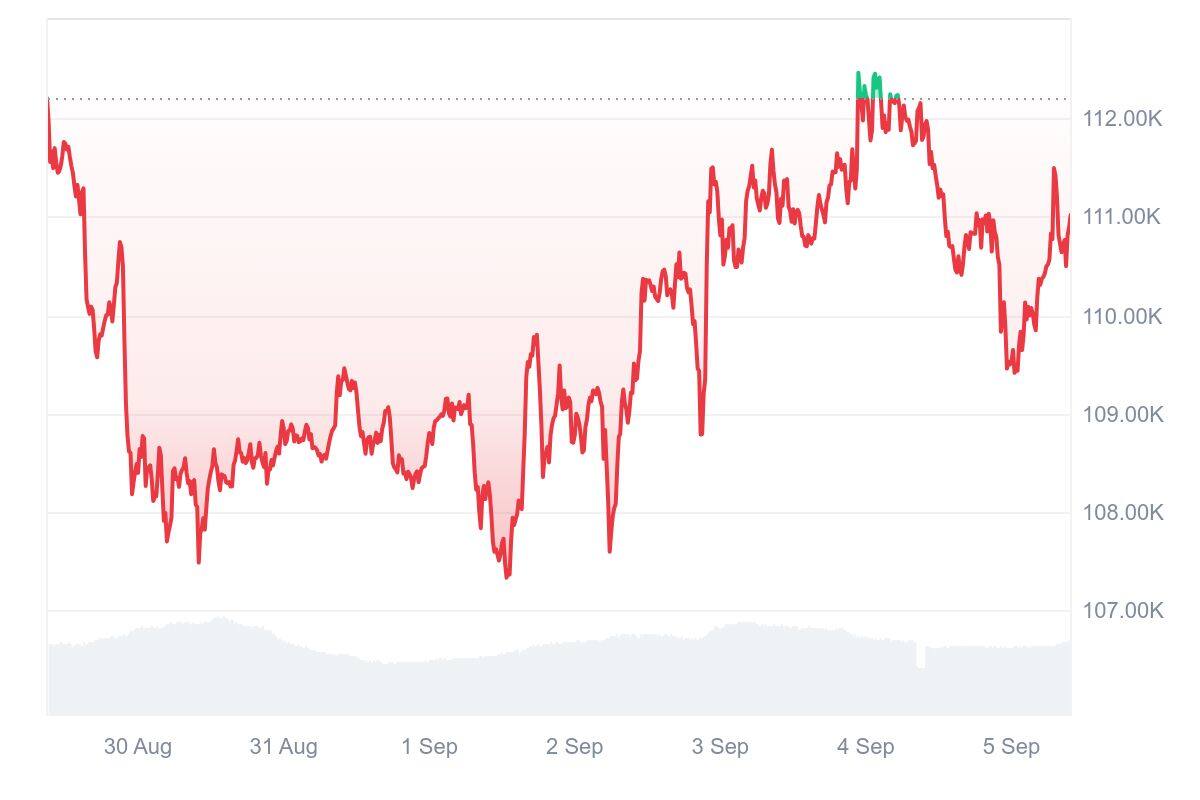
Bitcoin Price Trend (2025/08/30-2025/09/05)
This week, Bitcoin gradually recovered after experiencing a low-level consolidation, and it faced a phase adjustment ahead of the release of key macro data. The overall market structure still appears fragile, and investor sentiment remains defensive. As the release of the U.S. non-farm payroll data on September 5 approaches, the market generally adopts a wait-and-see strategy. Even with strong expectations for interest rate cuts, prices continue to show characteristics of fluctuation and correction.
Low-Level Consolidation Phase (August 30 - September 1)
On August 29, Bitcoin fell sharply from $113,042 to $108,178, a daily decline of about 4.4%. On the morning of August 30, it further dipped to $107,481 before stabilizing, and then fluctuated within the range of $108,000–$109,000. On August 31, the fluctuation range expanded to $108,200–$109,500.
One of the main reasons for the price drop was the profit-taking behavior of large whales:
According to CryptoOnchain monitoring, on August 29, Bitcoin realized profits close to $4 billion in a single day, marking the largest single-day profit-taking since February 2025, with the profit distribution as follows:
- Super Whales (>10,000 BTC): $2.17 billion
- Large Whales (1,000-10,000 BTC): $1.25 billion
- Other Whales (100-1,000 BTC): $495 million
The single-day realized profit of nearly $4 billion is the largest scale since February 2025. Such large profit realizations typically occur at phase tops, indicating a transfer of Bitcoin from "strong hands" to "weak hands," putting short-term pressure on the market. While it does not necessarily indicate a long-term decline, it is an important risk signal for short-term traders.
Bottoming and Gradual Recovery Phase (September 1 - September 4)
On the morning of September 1, after hitting a weekly low of $107,310, Bitcoin began to gradually rise, accompanied by an increase in volatility. From September 1 to 4, the price successively rose to $109,830, $110,636, $111,653, and $112,463, during which two rounds of technical corrections occurred on September 2, increasing market volatility.
The main drivers of this recovery include:
1. Technical Breakthrough: Bitcoin broke through a two-week downtrend line and regained the 100-day exponential moving average (EMA), indicating a strong short-term technical rebound.
2. Improvement in Market Sentiment: The sentiment in the cryptocurrency market shifted from "fear" to "neutral," with investor confidence gradually recovering.
3. Increased Institutional Demand: The demand from institutional investors and enterprises has risen, driving improvements in market liquidity.
4. Expectations of Federal Reserve Rate Cuts: The market generally expects a probability of over 90% for a rate cut by the Federal Reserve in September, stimulating demand for risk assets and providing support for Bitcoin prices.
Phase Adjustment Stage (September 4 - September 5)
On September 4, Bitcoin briefly surged above $112,000, then faced pressure and fell back to $110,407, briefly rebounding to around $111,000, and finally stabilizing at $109,411. On September 5, the price rebounded to $111,494 but failed to break through, and as of the time of writing, it fell back to $110,888.
The reasons for the short-term correction include:
Profit-Taking Pressure: After reaching key resistance levels, short-term funds chose to realize profits.
Weak Market Structure: The residual selling pressure from previous whale sell-offs still limits upward space.
Macroeconomic Uncertainty: Despite strong expectations for rate cuts, uncertainties regarding key data such as employment have led to a wait-and-see approach.
Summary and Outlook
Overall, Bitcoin's performance this week has shown a rhythm of "low-level bottoming – gradual recovery – phase adjustment." In the short term, the market still faces volatility risks, and price movements are highly sensitive to macro data and whale activities.
Investors should pay close attention to:
Whale Fund Flows — Whether they continue to realize profits or reposition.
Changes in Federal Reserve Policy Expectations — The timing and magnitude of rate cuts directly impact market sentiment.
Evolution of Market Sentiment — If it shifts from "neutral" to "greed," it may trigger a new round of breakthroughs.
Short-term operations should remain cautious, while mid- to long-term strategies should focus on the interplay between macro policies and institutional capital.
2. Market Dynamics and Macroeconomic Background
Capital Flows 1. ETF Fund Dynamics
This week, the trend of capital inflows into spot Bitcoin ETFs:
September 2: +$332.8 million
September 3: +$300.5 million
September 4: -$357.7 million

ETF Inflow/Outflow Data Image
Overall, capital continued to flow in during the first two days, reflecting strong market demand for Bitcoin. However, a significant outflow occurred on September 4, indicating that some funds chose to take profits, leading to a cautious short-term market sentiment.
- Whale and Long-Term Holder Movements
Ancient Bitcoin Whales Switching to ETH
On August 31, according to @mlmabc monitoring, a high-profile ancient Bitcoin whale has conducted the following operations in the past 11 days:
- Sold Bitcoin: 34,110 BTC (approximately $3.7 billion)
- Bought Ethereum: 813,298.84 ETH (approximately $3.66 billion)
- Still holding BTC: 32,321 BTC (approximately $3.5 billion) with unclear intentions
This whale seems to be gradually converting BTC holdings to ETH, but the true intentions remain unclear.
Long-Term Bitcoin Holders Set New Yearly High for Daily Sales
On September 1, Glassnode data showed:
- Total Bitcoin sold in a single day was approximately 97,000 BTC, setting a new high for 2025.
- About 34,500 BTC held for 1-2 years, approximately 16,600 BTC held for 6-12 months, and about 16,000 BTC held for 3-5 years.
- The three categories of holders accounted for about 70% of total spending.
Recent spending activities by long-term holders have accelerated, indicating that some investors are reacting to short-term market fluctuations.

BTC Long-Term Holders/Short-Term Holders Spending Volume
- Exchange and Market Data Cryptocurrency Exchange Trading Volume Hits Yearly High
On September 3, The Block data showed:
- Total trading volume of cryptocurrency exchanges in August: $1.86 trillion, a year-on-year increase of 5%.
- Binance: $737.1 billion (month-on-month increase of $31 billion)
- Bybit: $12.65 billion, Bitget: $12.61 billion
- Decentralized exchange (DEX) trading volume: $368.8 billion, Uniswap $143 billion, PancakeSwap $58.7 billion
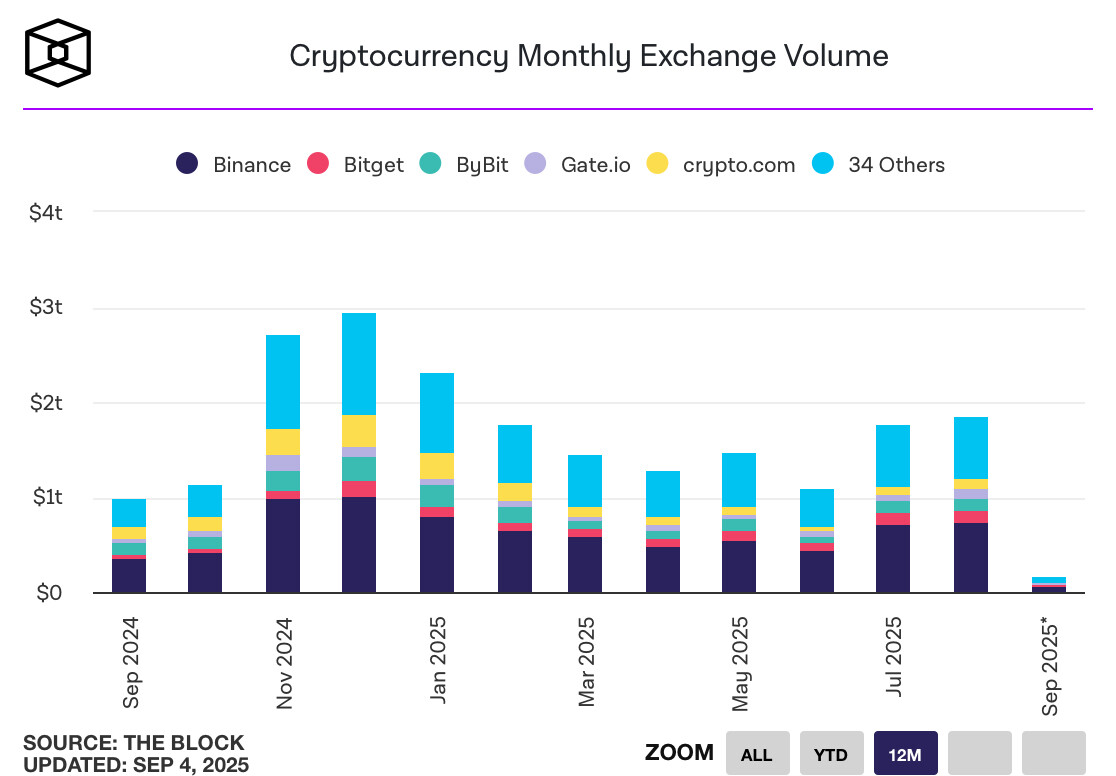
Cryptocurrency Exchange Monthly Trading Volume Data
ETH ETF Fund Inflows Set Record
- U.S. spot Ethereum ETF saw inflows of $3.87 billion in August.
- During the same period, Bitcoin ETF experienced outflows of $751 million.
Investor interest in ETH has significantly increased, indicating that funds are rotating from Bitcoin to Ethereum and other high-yield assets.

Bitcoin Spot ETF Monthly Inflow/Outflow Data
- Market Structure and Altcoin Movements
Decline in Bitcoin's Dominance
On September 4, The Block data showed:
- Bitcoin's share of the cryptocurrency market decreased to 55% (previous peak was 62%).
- Altcoins like ETH and SOL are attracting renewed attention from institutional and retail funds.
There are signs of capital rotation in the market, and if altcoins can form genuine spot demand, they may see an upward trend in the fourth quarter.
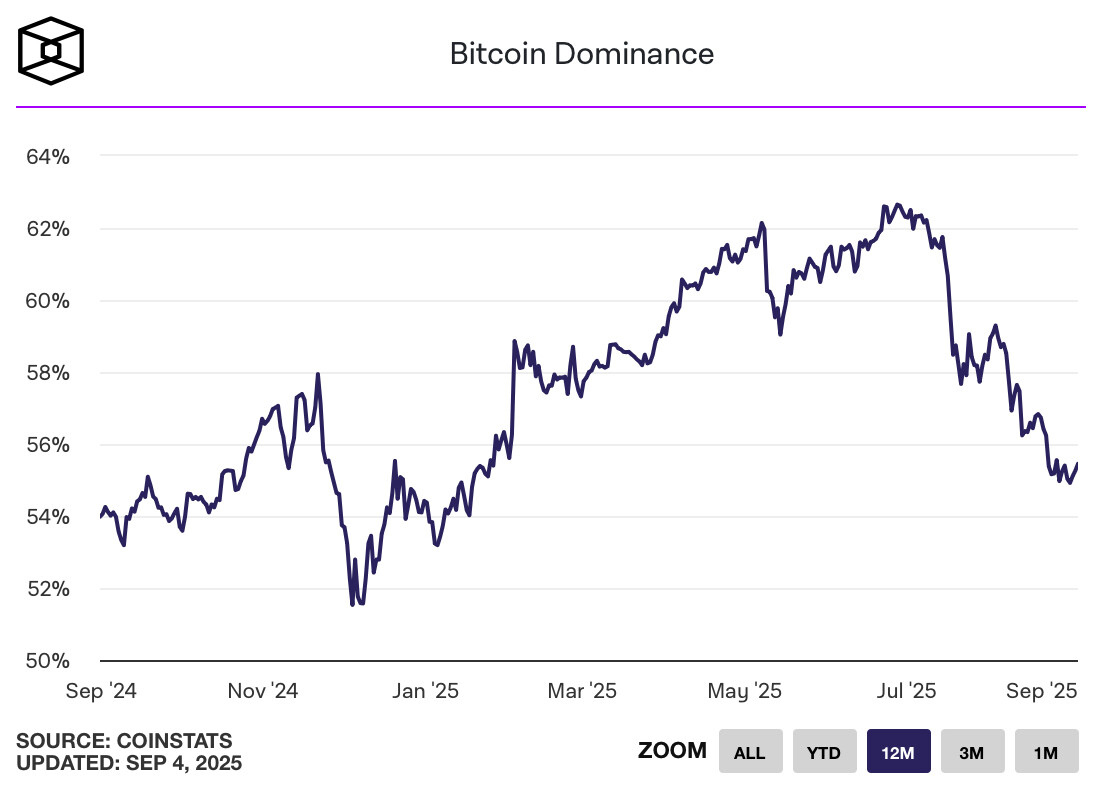
Bitcoin Dominance Data
ETH Exchange Reserves Hit Near 3-Year Low
On September 4, CryptoQuant data showed:
- Exchange ETH reserves dropped to about 17.4 million (down about 10.7 million from the peak in 2022).
- Withdrawal accelerated over the past three months, with about 2.5 million ETH leaving exchanges.
- Net inflows into spot ETH ETFs have exceeded $10 billion since July.
Increase in Whale Holdings
Whales holding 1,000 to 100,000 ETH have increased their holdings by 14% since April.
This indicates that large investors are continuously accumulating ETH at low levels.
Overall, capital flows indicate that selling pressure on Bitcoin has increased recently, while ETH and altcoins are receiving attention from institutions and whales, showing a trend of rotation towards high-risk assets in the market.
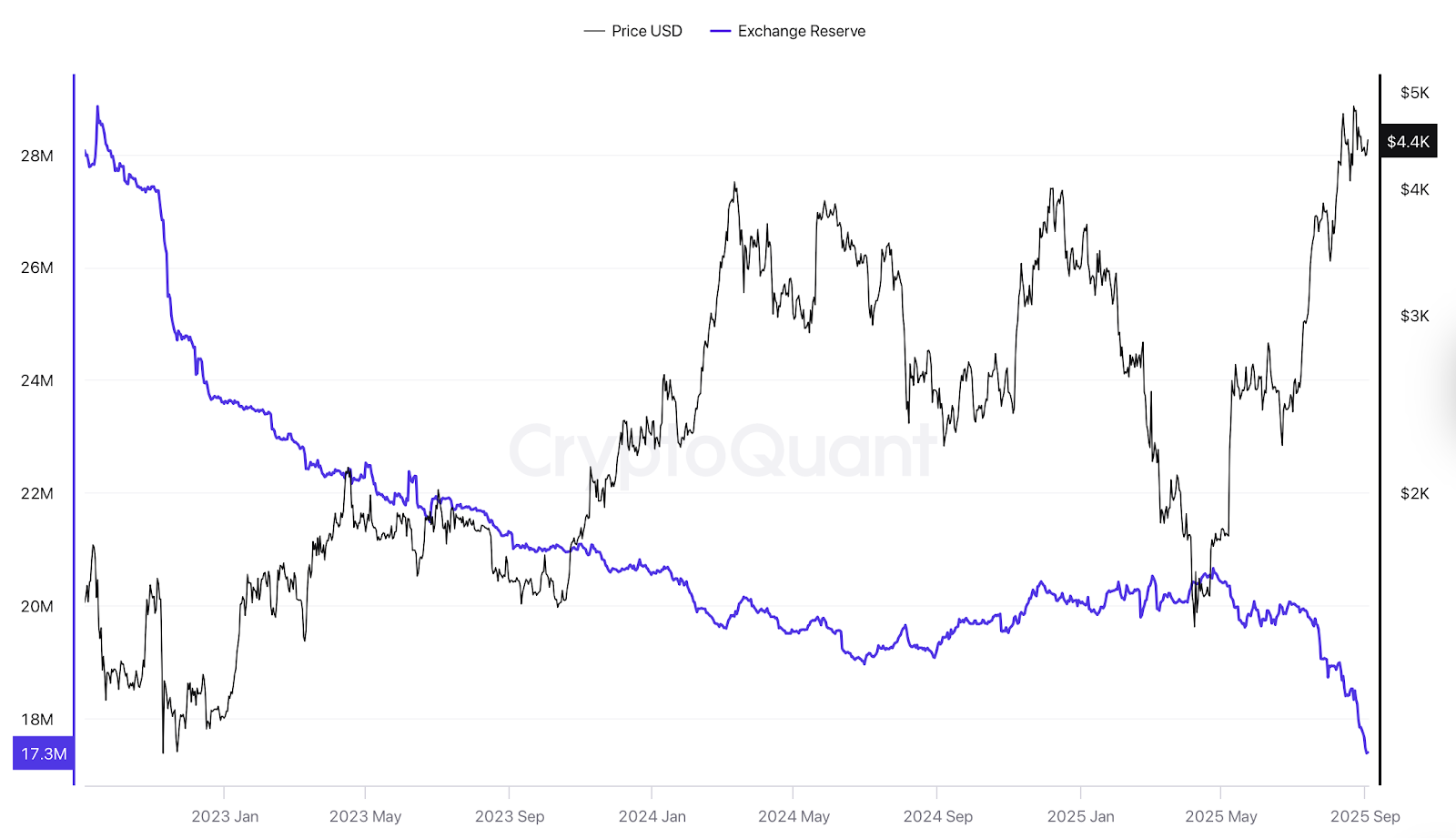
Ethereum Exchange Reserve Data
Technical Indicator Analysis
1. Relative Strength Index (RSI 14)
According to Bitbo data, as of September 5, 2025, the 14-day RSI for Bitcoin is 43.28. In terms of range, an RSI between 30 and 50 is generally considered a weak zone, indicating insufficient bullish strength and a relative dominance of bearish sentiment. The current RSI value shows that Bitcoin's short-term momentum is weak, with limited market inflows and a tendency for price performance to exhibit downward fluctuations. Although this level has not yet reached the oversold area below 30, it has revealed pressure from downward momentum. If the RSI continues to approach and stabilize around 40, the market may gain technical support in this area, potentially triggering a phase rebound; however, if it falls below 35, it will release a stronger bearish signal, suggesting that prices may face further downside risks. Overall, Bitcoin remains in a state of weak bullishness within the current RSI range, and investors need to closely monitor the performance in the 40-35 range to assess the strength transition of subsequent trends.
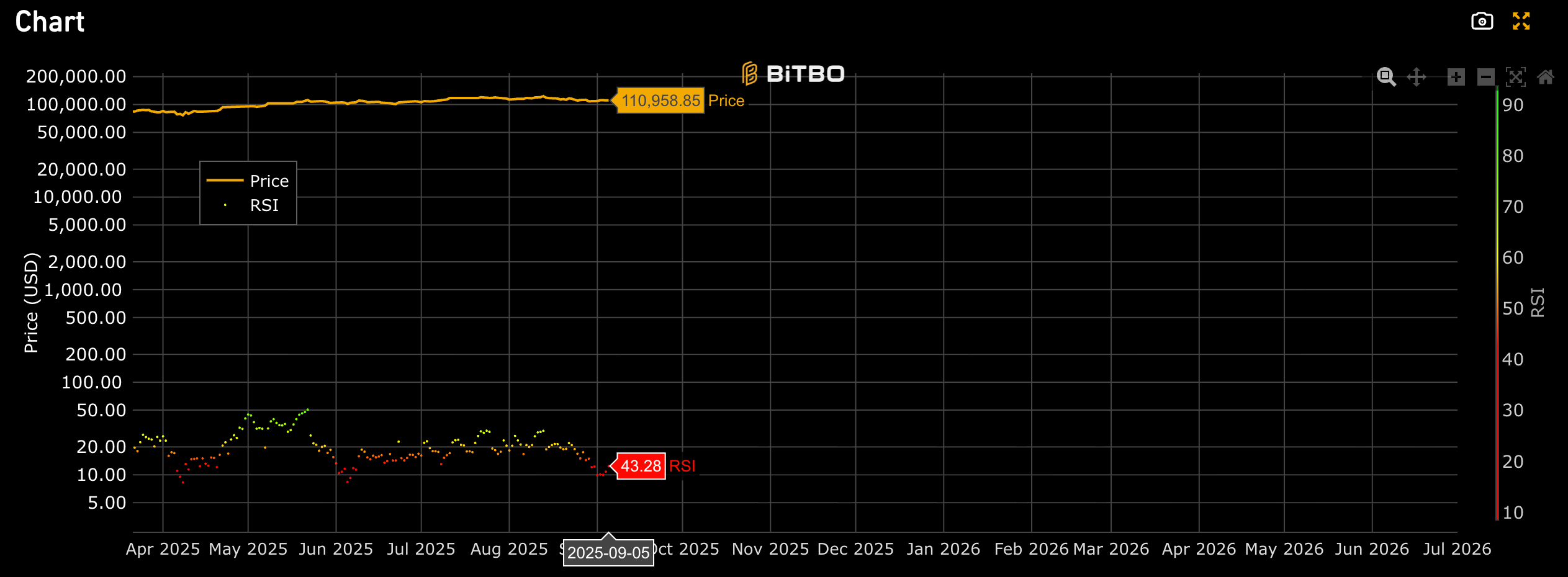
Bitcoin 14-Day RSI Data Image
2. Moving Average (MA) Analysis
MA 5 (5-Day Moving Average): $110,965
MA 20 (20-Day Moving Average): $115,054
MA 50 (50-Day Moving Average): $115,725
MA 100 (100-Day Moving Average): $109,705
MA 200 (200-Day Moving Average): $104,381
Current Price: $111,395

MA 5, MA 20, MA 50, MA 100 Data Image
In the short term, the current price is slightly above MA 5 ($110,965) but still significantly below MA 20 and MA 50, indicating that while there are slight signs of stabilization in the short-term price, it remains in a phase of overall correction.
In the medium term, both MA 20 and MA 50 are above the current price, forming a pressure zone, indicating that the medium-term resistance level is in the $115,000-$116,000 range. If the price cannot break through this range, the market may continue to maintain a weak consolidation.
In the long term, both MA 100 ($109,705) and MA 200 ($104,381) are below the current price, showing that the long-term trend still maintains a bullish pattern, and Bitcoin remains in a long-term upward channel.
Trend Interpretation:
Short-term: The price is expected to fluctuate around MA 5 and MA 100, roughly in the range of $109,700-$112,000.
Medium-term: If it can break through the pressure zone of MA 20 and MA 50 (around $115,000), it is expected to return to an upward trend.
Long-term: As long as the price does not fall below MA 200 (around $104,000), Bitcoin's long-term bullish structure remains intact.
3. Key Support and Resistance Levels
Support Levels: The key short-term support areas are at $110,500 and $109,500. On September 3, Bitcoin's price retraced to the $110,500 level twice without further declines, indicating strong buying support at this price level. Subsequently, during the pullback on September 4, the $109,500 support level was again validated, effectively curbing the downward momentum, showing that buying interest in this area is relatively strong. If this level is lost, the next line of defense will be at $109,000.
Resistance Levels: Short-term resistance is mainly concentrated in the $112,000 – $113,000 range. From a technical structure perspective, $112,000 is the upper boundary of a previous dense trading area, compounded by short-term moving average pressure, making it a primary breakout point. If the price can effectively break through and stabilize above $112,000, it is expected to further challenge the $113,000 level. This area has concentrated bearish selling pressure and is expected to become a strong resistance for the short-term market.
Comprehensive Analysis
Overall, Bitcoin's short-term trend remains in a range-bound consolidation pattern, with bullish and bearish forces repeatedly battling in the $109,500 – $112,500 range. The support levels below are progressively stronger, indicating a strong willingness to buy, while the resistance zone above shows significant pressure, making breakthroughs challenging. Before an effective breakout occurs, the market is likely to maintain range consolidation. If it can stabilize above $112,000, it will open up further upward space; conversely, if $109,500 is broken, caution is warranted as prices may seek confirmation at $109,000 or even lower support levels. In short-term operations, it is advisable to pay attention to changes in support and resistance within the range and remain flexible in response.
Market Sentiment Analysis
As of September 5, the Fear & Greed Index reports 41 points, situated at the lower end of the "neutral" range, indicating that market sentiment remains cautious, with investors generally maintaining a defensive posture.
Looking back at this week (August 30 – September 5), the daily values of the Fear & Greed Index were: 39 (close to the edge of the "fear" range), 40 (neutral edge), 39 (neutral edge), 39 (neutral edge), 42 (lower end of neutral), 44 (neutral). The overall range operated between 39 and 44 points, with limited volatility.
Overall, Bitcoin's market sentiment this week has remained oscillating at the lower end of "neutral," with investors adopting a cautious and conservative attitude. Although fear sentiment has not further intensified, there is a strong atmosphere of capital waiting on the sidelines, indicating that the market still lacks strong upward momentum. If subsequent prices can effectively stabilize and break through key resistance levels, market sentiment may further recover; conversely, if prices fall back again, the index may drop into the "fear" range.

Fear and Greed Index Data Image
Macroeconomic Background
1. Federal Reserve Beige Book Released
Released this Wednesday (September 3), it shows that economic activity in most regions of the U.S. has "remained nearly unchanged" or "slightly weakened," with the labor market remaining stable and inflation on a moderate rise. The report points out structural challenges such as cautious corporate buying, AI replacing some jobs, reluctance to fill positions in institutions, and a decrease in immigrant labor.
The market generally expects the Federal Reserve to take interest rate cut measures at the FOMC meeting on September 16-17.
The combination of a weakening economy and increased expectations for rate cuts typically drives investors toward non-traditional assets (such as Bitcoin) to seek inflation hedges or risk offsets.

Related Image
2. Employment Data Release Imminent
The U.S. non-farm payroll report for August will be released this Friday (September 5, 08:30 ET), with the market generally predicting an increase in employment of about 73,000–75,000, and the unemployment rate may slightly rise to 4.3%.
If the employment data is weaker than expected, it will further strengthen rate cut expectations, benefiting risk assets including Bitcoin.
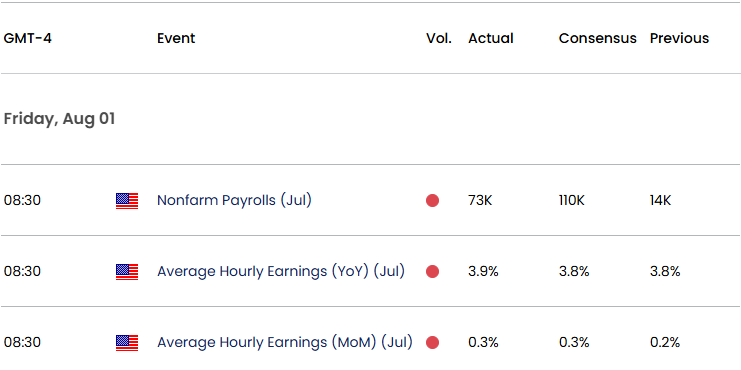
Related Image
3. U.S. Market: Rising Political Risks and Macroeconomic Uncertainty
Trump's Tariffs and Federal Reserve Interventions Cause Market Tension
A court ruled that most of his tariff measures are illegal, raising concerns in the market about refund risks exacerbating fiscal pressure, leading to soaring bond yields and significant market volatility. This has also increased the appeal of safe-haven assets like gold and Bitcoin.
Investor Uncertainty About Future Policies Increases
Trump's attempts to influence the independence of the Federal Reserve have heightened market concerns, prompting capital to flow into alternative assets, including gold and Bitcoin.

Related Image
4. Tech Giants Boost Brief Stock Market Recovery
Alphabet and Apple Stock Prices Surge
Alphabet's stock soared about 9% after winning an antitrust case, maintaining its rights to the Chrome browser and collaborating with Apple, which also saw a nearly 4% increase during the same period.
Cryptocurrency Asset "American Bitcoin" Soars
American Bitcoin (stock code ABTC), a Bitcoin mining company related to the Trump family, surged nearly 17% on its first day of trading on Nasdaq, reaching $8.04 per share, with intraday prices hitting around $14. The stock traded over 29 million shares on its first day on Nasdaq.
5. Safe-Haven Assets Rise
Gold Hits All-Time High
On September 2, gold prices climbed to about $3,578 per ounce, reflecting market unease over U.S. policies and economic turmoil, while supporting Bitcoin's recent upward trend.

Related Image
6. Asia-Pacific Region's Policies and Economic Performance Remain Robust
Malaysia's Central Bank Maintains Stable Interest Rates
The central bank announced on September 4 that the key overnight rate will remain at 2.75%, expected to last until 2027. This decision was made against a backdrop of moderate inflation and sustainable economic growth.
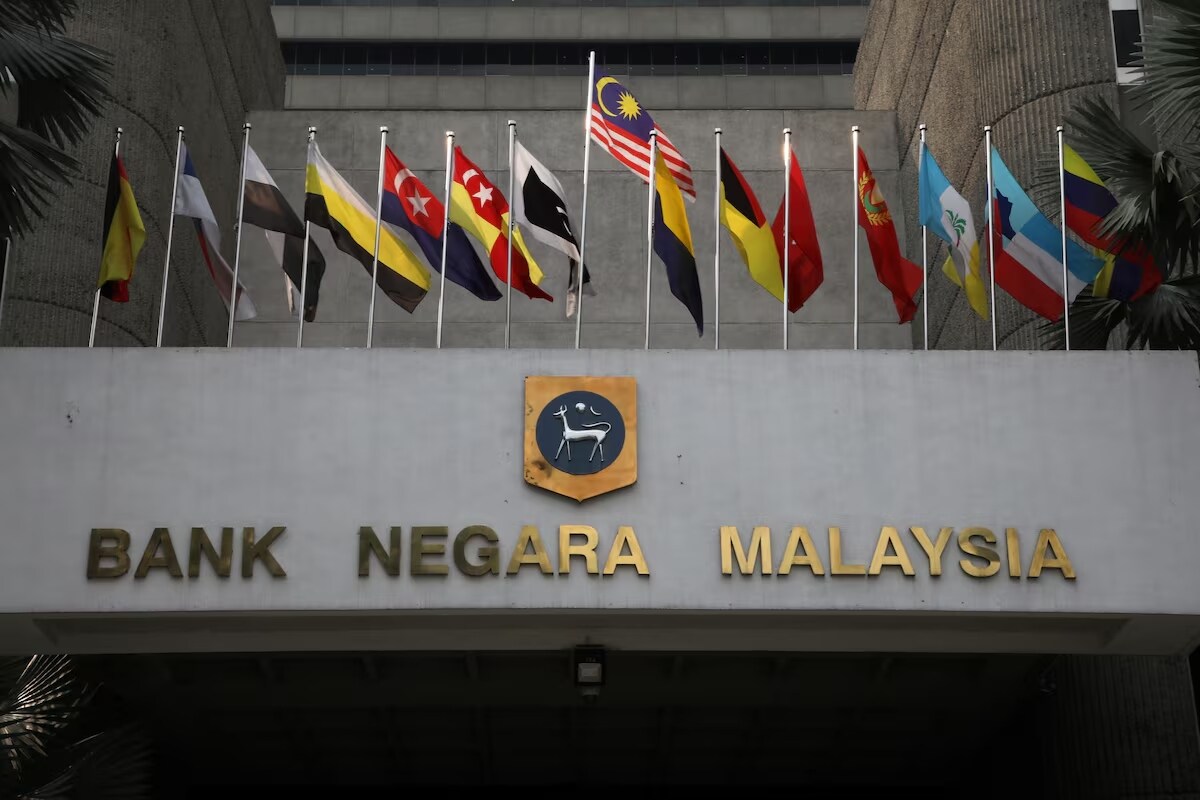
Related Image
7. Market Seasonality and Changes in Risk Appetite
September Market Risks Draw Attention Again
Historically, September is a poor-performing month for U.S. stocks, compounded by peak debt issuance, rebalancing, and policy ambiguity, making the market particularly vulnerable this week. Both stocks and bonds are under pressure, with rising volatility as investors seek safe-haven paths.
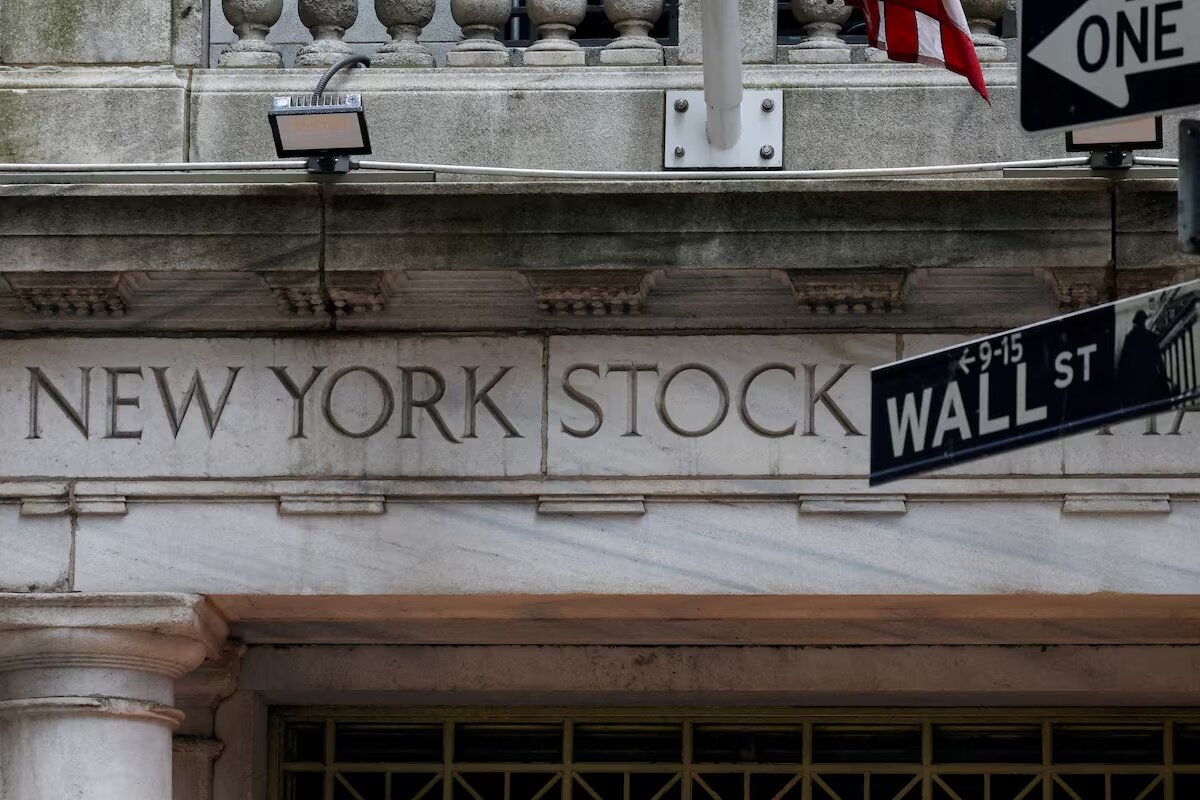
Related Image
3. Hash Rate Changes
In the past week, the Bitcoin network hash rate has shown a broad fluctuation characteristic, forming a periodic fluctuation pattern of "decline - rise - decline."
From the specific trends:
- From August 30 to September 1, the hash rate continued to decline, dropping from 1.1569 ZH/s to around 1 ZH/s and consolidating, followed by a slight rebound, but ultimately refreshed the weekly low on September 1, falling to 847.53 EH/s.
- From September 1 to September 2, the hash rate rose and broke through, not only recovering above 1 ZH/s but also setting a historical high of 1.2556 ZH/s on September 2, indicating a concentration of short-term computing power release.
- From September 2 to September 3, the hash rate gradually declined, sliding down from the peak to around 850 EH/s.
- From September 3 to September 4, the fluctuations eased, with the hash rate oscillating around 850 EH/s on September 3, and slightly rising to 987.81 EH/s on September 4, overall operating in the range of 850 EH/s to 1 ZH/s.
- On September 5, the hash rate fell again to around 900 EH/s, reporting 905.55 EH/s at the time of writing.
Overall, the Bitcoin network's computing power has fluctuated frequently at high levels this week, showing strong resilience. This may reflect periodic online and offline phenomena of some mining farms due to electricity costs, regional climate, and temporary maintenance, while also indicating that large mining machine groups are flexibly switching operational states between different electricity price windows.
Outlook
On September 2, Bitcoin's daily computing power reached a historical high of 1.279 ZH/s, refreshing the network record, but during the same period, Bitcoin's price remained basically flat over the past 24 hours. This indicates that the expansion of computing power on the miner's side is not completely synchronized with market prices, reflecting more the rhythm of mining machine capacity deployment and the allocation of electricity resources.
At the same time, the seven-day moving average of Bitcoin's hash rate has recently broken through 1 ZH/s, confirming that the overall network computing power is entering a high operating range. If this trend continues, it means that the security of the Bitcoin network will further strengthen, but it may also accelerate the exit of some small and medium miners, as the mining difficulty may rise in the next adjustment under a high computing power environment.
In the coming week, the following factors need to be closely monitored:
Mining difficulty adjustment: If the computing power remains at the current high level, a significant increase in the next difficulty cycle is expected, raising miners' marginal costs.
Energy market fluctuations: As some regions enter seasonal electricity peaks, mining farms may experience cliff-like fluctuations in computing power again, affecting the stability of the overall network hash rate.
Macroeconomic environment: If Bitcoin's price remains flat for a long time while computing power stays high, the profit margins of some high-cost miners will be further compressed.
In summary, the current high-level fluctuation state of Bitcoin's computing power is more likely a "phase peak release," and it may continue to fluctuate within the range of 900 EH/s to 1.2 ZH/s in the short term. In the medium to long term, further judgment on the sustainability of the computing power trend will depend on Bitcoin's price movements and the results of mining difficulty adjustments.
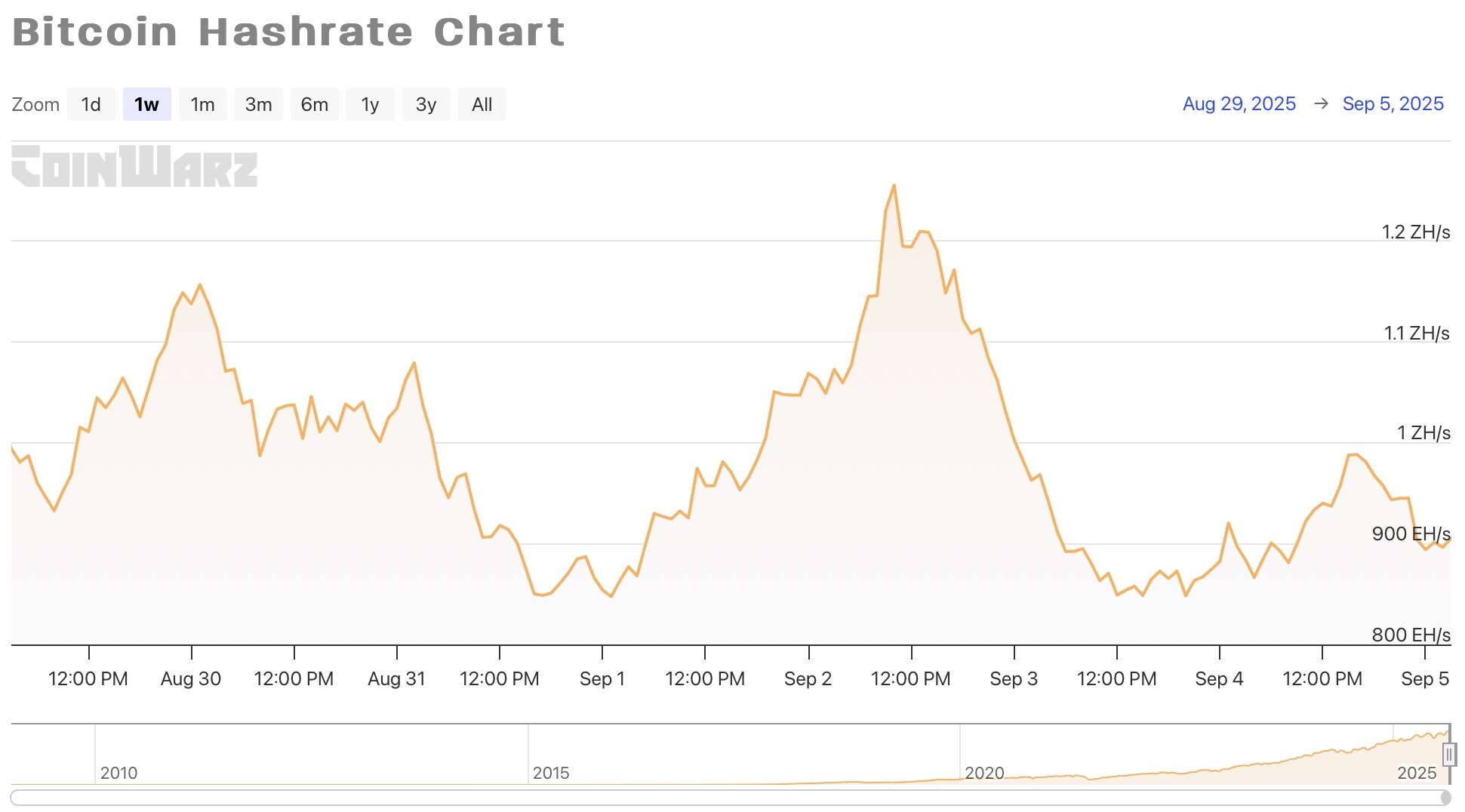
Weekly Bitcoin Network Hash Rate Data
4. Mining Revenue
According to YCharts data, in the past week, the average daily total revenue of Bitcoin miners (including block rewards and transaction fees) fluctuated between $46.67 million and $61.01 million, as follows:
August 30: $54.71 million
August 31: $46.67 million
September 1: $58.51 million
September 2: $61.01 million
September 3: $49.23 million
September 4: $50.42 million

Bitcoin Miners Daily Revenue Data
Overall, Bitcoin miners' revenue showed a range-bound fluctuation trend this week. After a brief spike on September 2, revenue fell back, mainly influenced by Bitcoin price fluctuations, changes in network computing power, and transaction fee levels.
From the perspective of daily earnings per unit of computing power (Hashprice), Hashrate Index data shows that as of September 5, 2025, the Hashprice was $54.47 per PH/s per day. This week, Hashprice moved in line with Bitcoin's price trend, showing a gradual rise after a low-level consolidation, reaching a weekly low of $52.49 per PH/s per day on September 1 and rising to a weekly high of $55.12 per PH/s per day on September 4. The overall trend shows a gradual recovery after low-level fluctuations, followed by a phase adjustment, which is basically consistent with Bitcoin's price. This also indicates that the current mining economic model is still primarily price-driven, while the continuous growth of computing power is gradually eroding miners' profit margins in the medium to long term.
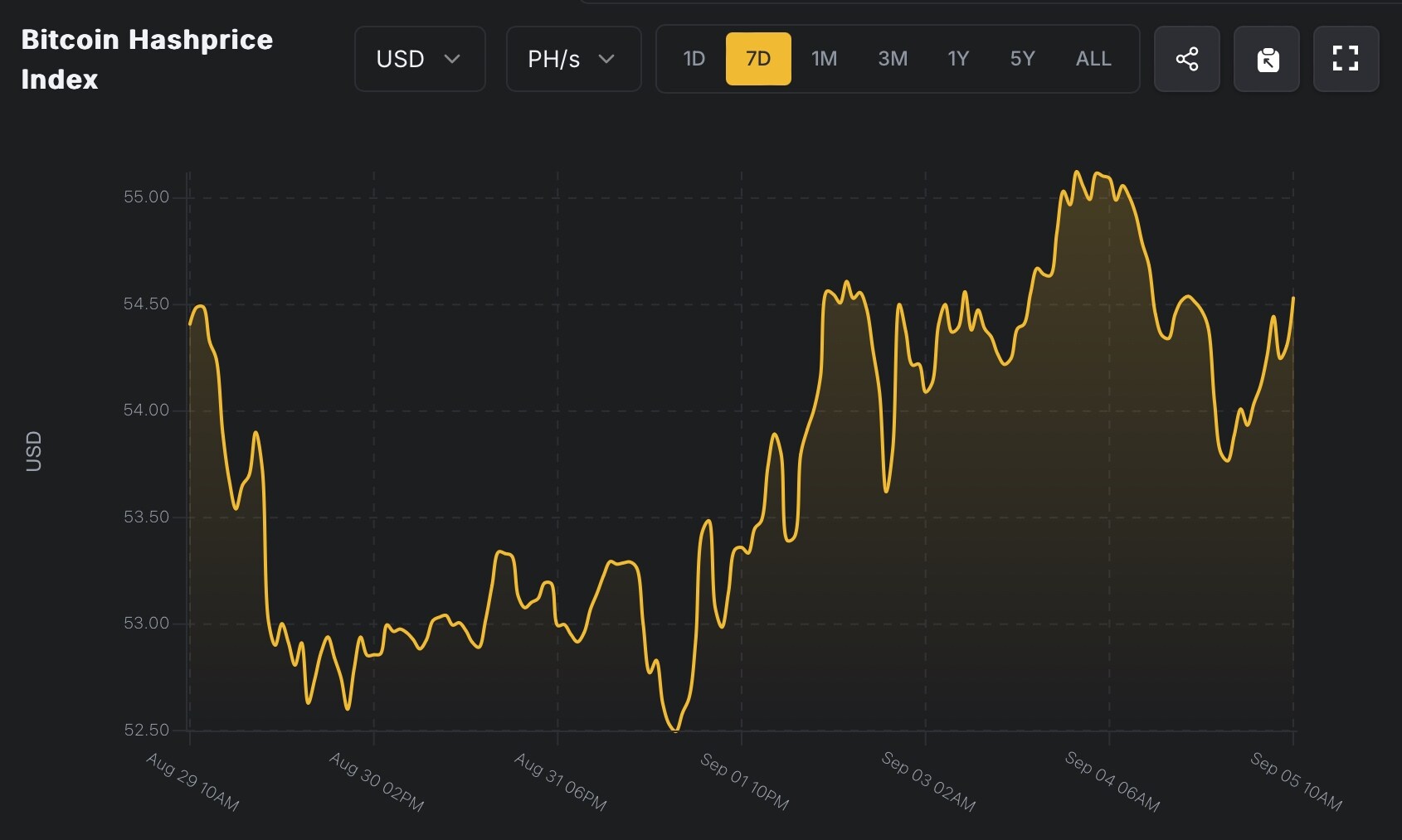
Hashprice Data
August Monthly Mining Revenue Review
According to The Block data, in August 2025, the total revenue of Bitcoin miners was approximately $1.66 billion, remaining basically flat compared to July (which also had a revenue of $1.66 billion). However, the continuous decline in Bitcoin prices in late August, coupled with the steady rise in network computing power, significantly suppressed the upward space for miners' overall revenue.
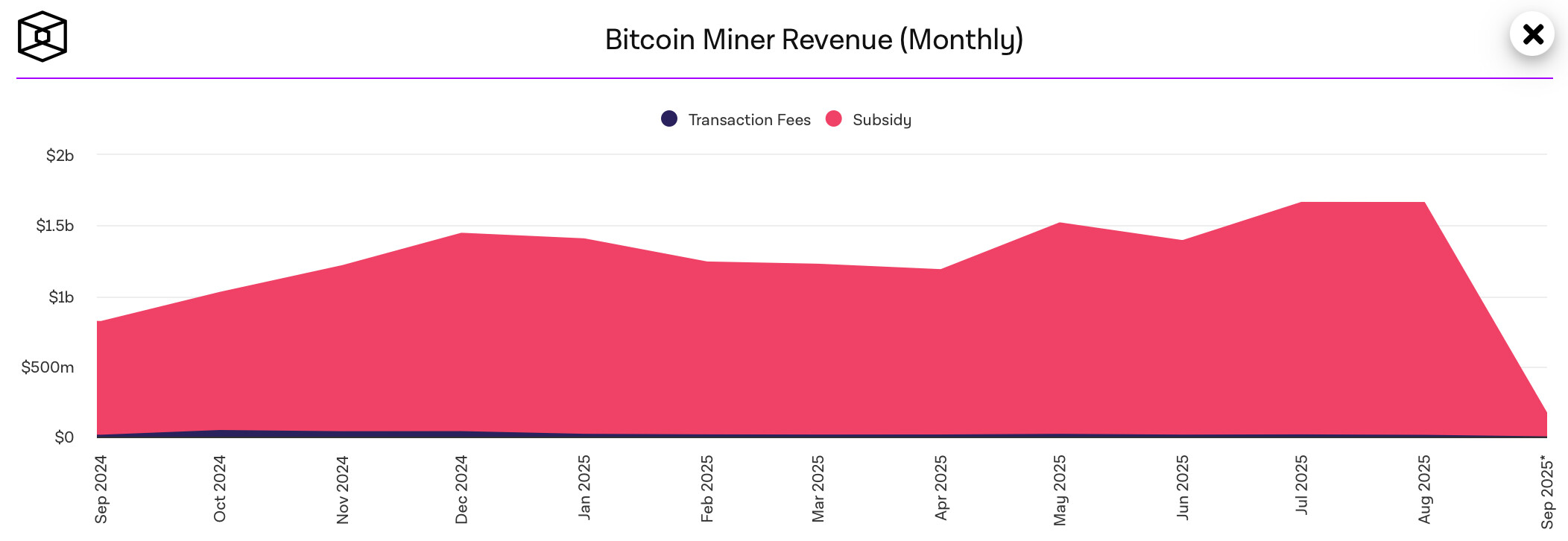
Bitcoin Miners Monthly Revenue Data
Future Outlook
In the short term, mining revenue will still be squeezed by both Bitcoin price fluctuations and the continuous growth of overall network computing power. If the price fails to break through previous highs, miners' profitability will be further pressured.
In the medium term:
If the price returns to an upward trend, miners' revenue is expected to recover, and Hashprice will also improve accordingly.
If computing power continues to expand (driven by the deployment of new generation mining machines and the addition of computing power in North America, Kazakhstan, etc.), Hashprice may further decline, exacerbating the profit differentiation in the industry.
Some high-cost miners may face profitability difficulties, leading to a phenomenon of computing power clearing and centralization in the industry, which could actually benefit leading mining companies.
5. Energy Costs and Mining Efficiency
According to CloverPool data, as of September 5, 2025, the total computing power of the Bitcoin network reached 975.41 EH/s, with a mining difficulty of 129.70 T. The next difficulty adjustment is expected to occur on the same day, with an estimated increase of about 4.93%, bringing the adjusted difficulty to approximately 136.10 T. This trend indicates that Bitcoin network computing power is still steadily growing, and competition among miners is intensifying. An increase in difficulty means that under the current electricity cost and hardware efficiency conditions, the mining difficulty for each block will further increase, requiring miners to have more efficient mining machines or lower-cost electricity to maintain profitability.
In the long term, difficulty increases are usually accompanied by a trend of computing power centralization, where large-scale mining farms and miners with efficient ASIC mining machines hold an advantage in profit margins. For small and medium miners, if electricity costs or equipment efficiency cannot match the difficulty increase, their mining revenue may be compressed.

Bitcoin Mining Difficulty Data
From the perspective of mining costs, according to the latest model calculations from MacroMicro, as of August 3, 2025, the unit production cost of Bitcoin was approximately $96,844.76, while the spot price during the same period was $111,723.21, resulting in a Mining Cost-to-Price Ratio of 0.84, indicating that miners still have an average gross profit margin of about 16%. This data shows that while miners remain profitable, their profit levels have slightly tightened compared to earlier periods. This may be related to the rising mining difficulty and changes in Bitcoin prices, with the market experiencing slightly increased profit pressure in the short term, but still maintaining considerable profit margins to support miners' continued participation in network maintenance.
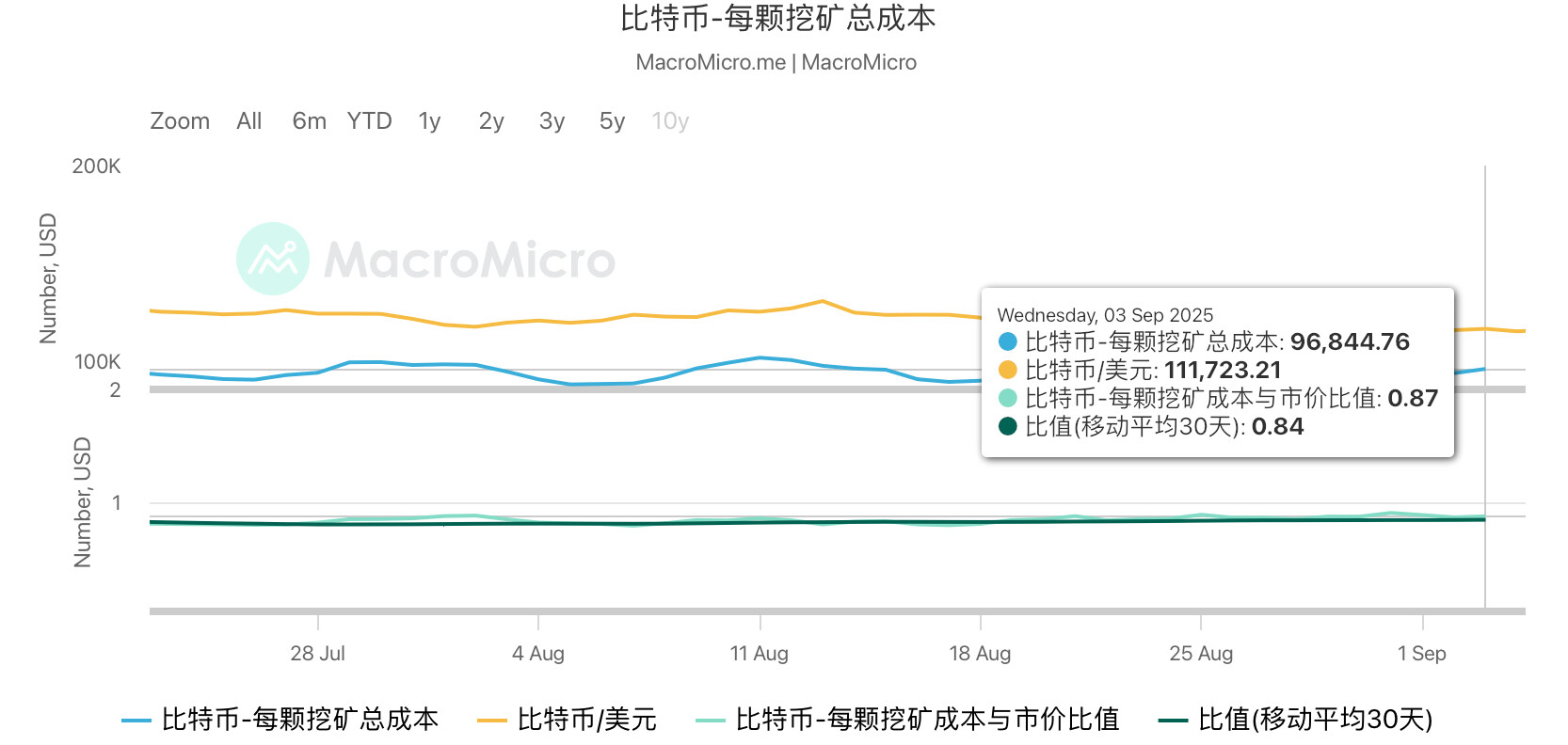
Total Mining Cost per Bitcoin Data
At the same time, the on-chain indicator Puell Multiple has decreased, maintaining in the range of 1.24 to 1.28. The Puell Multiple measures the ratio of the daily Bitcoin issuance value to its annual average issuance value, used to assess miners' profitability and the degree of market overheating. The current level indicates:
Miners remain profitable, but their profit margins have been compressed compared to historical highs.
When the Puell Multiple is below 2, it usually indicates that market mining profits are moderate or low, and the market is not in an overheating state, which is beneficial for the healthy accumulation of Bitcoin.
Combining the cost-to-price ratio, although miners are profitable, market pressure may gradually increase, especially in the case of rising difficulty or fluctuations in electricity costs, putting high-cost miners under profit pressure.
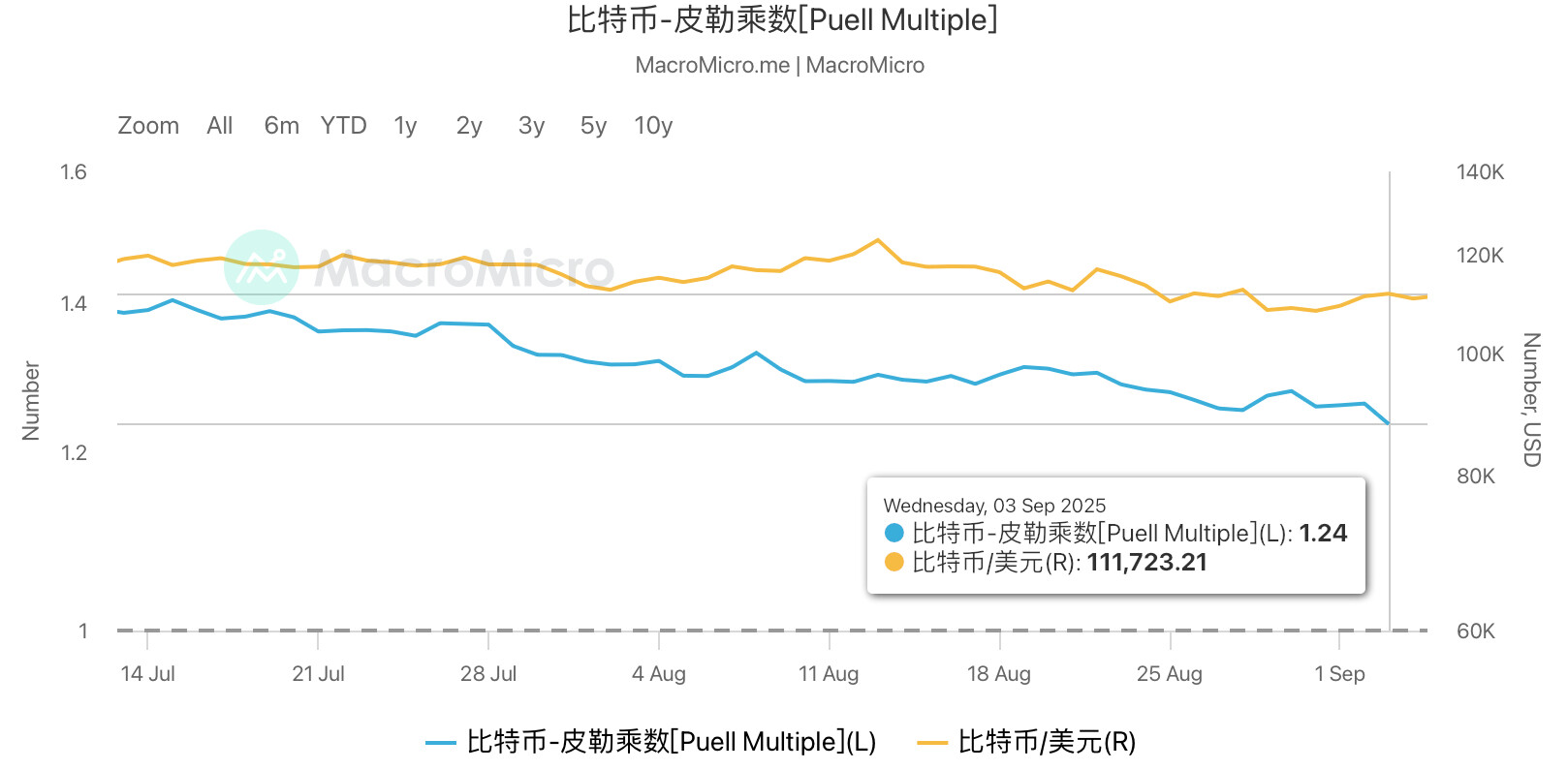
BTC Puell Multiple Data
In summary, the total computing power of the Bitcoin network continues to grow, and network security remains robust. However, with the increase in mining difficulty and changes in Bitcoin prices, miners' profit margins have been compressed. Considering computing power, costs, and on-chain indicators, the current Bitcoin mining ecosystem is stable, but future attention is needed on the impacts of difficulty increases, electricity cost fluctuations, hardware efficiency changes, and Bitcoin price fluctuations on miners' marginal returns and network computing power.
6. Policy and Regulatory News
Indian Court Sentences 14 Individuals to Life Imprisonment in Cryptocurrency Extortion Case
On August 30, it was reported by Deshgujarat that an Indian anti-corruption court sentenced 14 individuals to life imprisonment, including 11 police officers and a former legislator of the Bharatiya Janata Party (BJP), for kidnapping an Indian businessman and extorting cryptocurrency. The judge found the gang guilty of criminal conspiracy, kidnapping for ransom, illegal detention, and assault.
It is reported that Indian businessman Shailesh Bhatt recovered part of his investment in Bitcoin after the collapse of the BitConnect company. However, after learning that he had retrieved part of his investment, the aforementioned officials plotted a kidnapping scheme to seize the cryptocurrency. Ultimately, Shailesh Bhatt agreed to transfer part of his Bitcoin and $3.6 million in cash before being released.

Related Images
Pionex: In August, cryptocurrency security incidents caused losses of $163 million, an increase of 15% compared to July.
On September 1, according to PeckShieldAlert monitoring, there were approximately 16 major cryptocurrency security incidents in 2025, with total losses reaching $163 million, up 15% from $142 million in July.
Among them, the five largest security incidents were: a Bitcoin holder lost $91.4 million; the Turkish cryptocurrency exchange BTCTurk suffered a loss of $54 million; the ODIN•FUN project lost $7 million; BetterBank.io lost $5 million; and CrediX Finance lost $4.5 million. Notably, BTCTurk has experienced two major security incidents in the past year, with cumulative losses exceeding $100 million after losing $54 million in 2024.
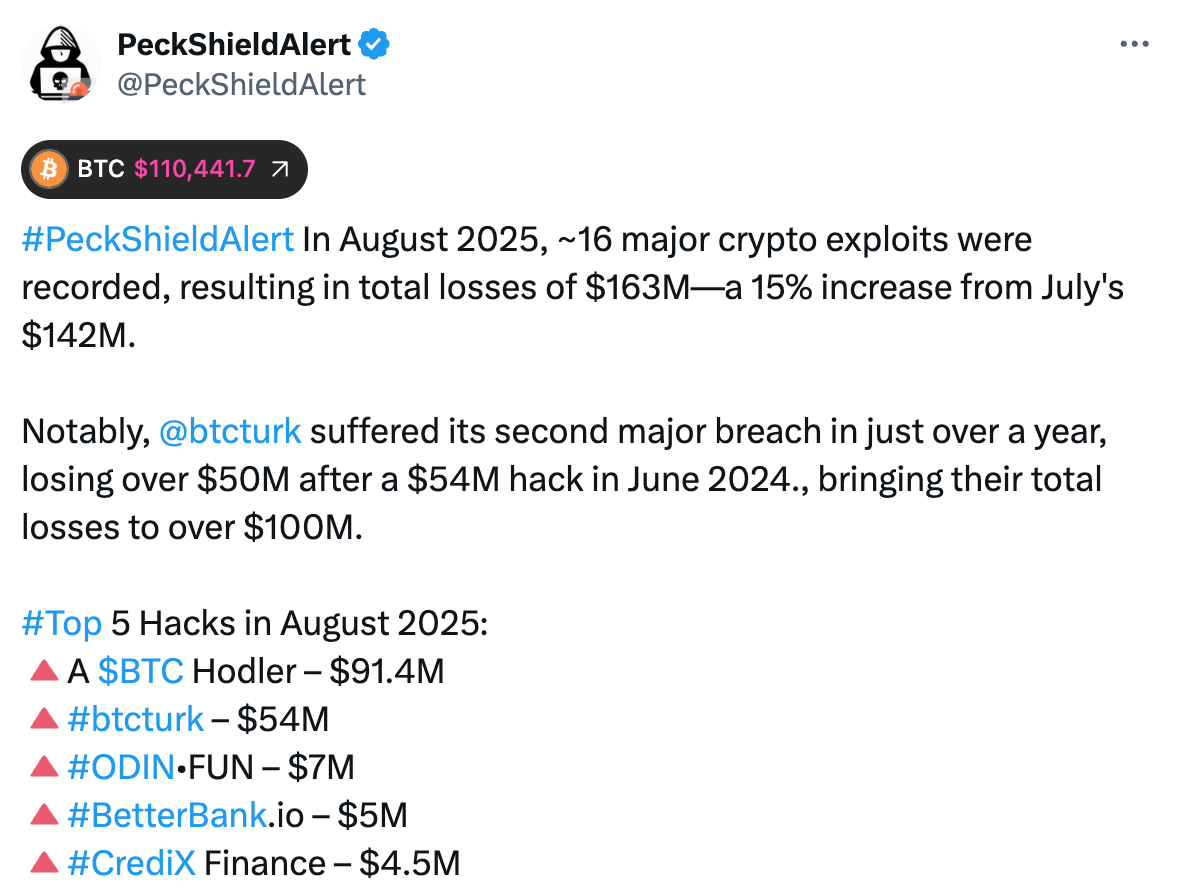
Related Images
7. Mining News
IREN to Pay $20 Million to NYDIG to Resolve Dispute Arising from Bitcoin Mining Equipment Loan Default
On August 30, it was reported by Theminermag that Nasdaq-listed Bitcoin mining company IREN stated in its annual report that it would pay $20 million to NYDIG to resolve disputes arising from defaults on Bitcoin mining equipment loans over the years.
The settlement agreement was reached in August, with IREN involved in a debt of $107.8 million owed at the end of 2022, including interest and late fees. These loans were arranged through NYDIG in 2021 to finance approximately 35,000 Antminer S19 mining machines. IREN stated that the settlement agreement ends all related lawsuits and protects its subsidiaries, executives, and shareholders from further claims, and is currently awaiting court approval for formal closure.

Related Images
Research: Corporate Bitcoin Purchases Are About Four Times the Mining Rate
On August 31, it was reported by CoinDesk that Bitcoin financial services company River stated in a research report that the amount of Bitcoin absorbed by corporations far exceeds the amount created by miners.
Corporations absorb about 1,755 Bitcoins daily, while the new issuance of Bitcoin is about 450 Bitcoins per day in 2025, meaning that the amount absorbed by corporations is nearly four times the supply from miners. Funds and spot ETFs add another 1,430 Bitcoins daily, further boosting institutional demand.
Data: An Independent Miner Successfully Mined a New Bitcoin Block, Earning About $340,000
On September 2, it was reported by Cointelegraph that an independent miner successfully mined Bitcoin block 912632 24 hours ago, earning approximately $340,000.
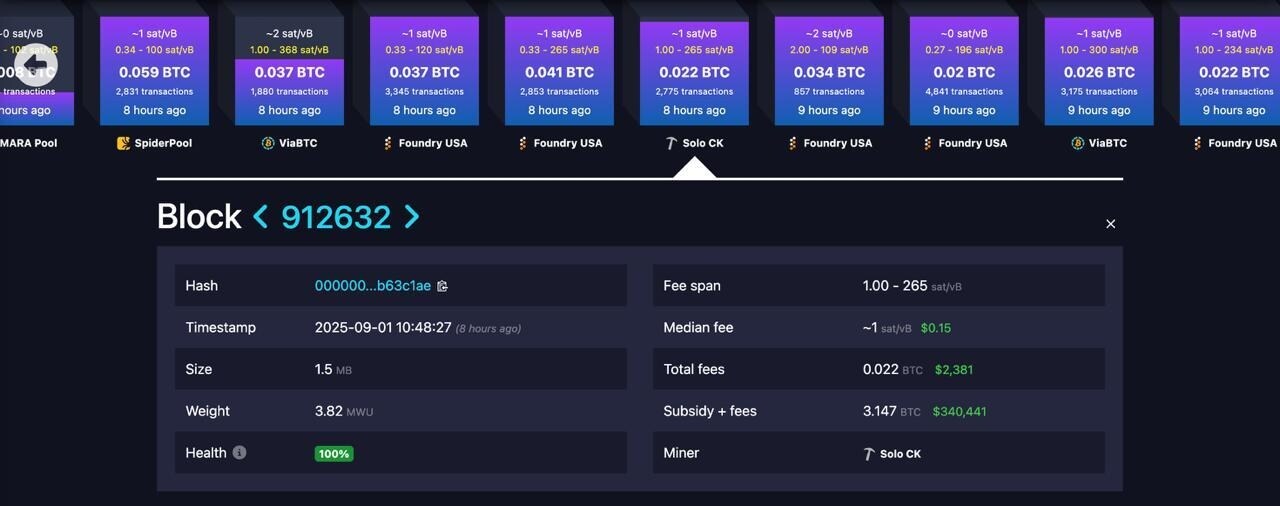
Related Images
JPMorgan: The Total Market Value of 13 U.S. Listed Bitcoin Mining Companies Reached a Historical High in August, Increasing by 23% Month-on-Month
On September 2, JPMorgan released a research report indicating that the Bitcoin network hash rate returned to a historical high last month, averaging 949 EH/s. The total market value of 13 U.S. listed Bitcoin mining companies reached a historical high of approximately $7.4 billion, an increase of 23% month-on-month. TeraWulf outperformed other companies, rising by 83%, while Greenidge Generation (GREE) underperformed, falling by 22%.
American Bitcoin (ABTC), Backed by the Trump Family, Successfully Listed on Nasdaq, with Stock Price Rising Nearly 17% on the First Day
On September 3, it was reported that American Bitcoin (ABTC), a Bitcoin mining company backed by the Trump family, completed its merger with Gryphon Digital Mining and listed on Nasdaq. Donald Trump Jr. and Eric Trump, along with mining company Hut 8, collectively hold 98% of the new entity. On September 4, the company's stock price rose nearly 17% to $8.04, reaching a peak of $14 during trading, with a high trading volume exceeding 29 million shares. Eric Trump stated that their mining costs are only half of the Bitcoin market price and that they have hundreds of millions in assets and data centers to support them. According to Bloomberg's calculations, their shareholding value has exceeded $500 million. American Bitcoin also plans to emulate MicroStrategy by acquiring listed companies in Japan and Hong Kong to create a Bitcoin reserve platform.

Related Images
Donald Trump Jr.-Backed Thumzup to Purchase 2,500 DOGE Mining Machines and Increase Holdings in SOL, LTC, XRP, and ETH Cryptocurrencies
On September 5, it was reported by PRNewswire that Thumzup Media Corporation, a social media company invested in by Donald Trump Jr. that holds cryptocurrency reserves, released a shareholder letter stating that the company has spent $1 million to purchase Bitcoin. Additionally, its board has authorized increasing holdings in cryptocurrencies such as DOGE, LTC, SOL, XRP, ETH, and USDC. The company has also reached a final agreement to purchase 2,500 DOGE mining machines, with plans to potentially add another 1,000 mining machines.
8. Bitcoin News
Global Corporate and National Bitcoin Holdings (This Week's Statistics)
1. Bitcoin Treasury Capital Raises 2 Million Swedish Krona and Will Continue to Purchase Bitcoin
On August 30, Swedish listed company Bitcoin Treasury Capital announced the results of its warrant exercise, raising approximately 2 million Swedish Krona. The company plans to use the funds to continue purchasing Bitcoin.
2. China Financial Leasing Group Invests in Bitcoin and Ethereum ETFs
On August 30, China Financial Leasing Group disclosed in its mid-term performance report that it has begun investing in cryptocurrency ETFs, focusing on products that hold physical assets. It currently mainly holds BlackRock's Bitcoin Trust ETF, Huaxia Bitcoin ETF, and Ethereum-related ETFs.
3. El Salvador Increased Holdings by 8 BTC in One Week, Total Holdings Reach 6,285 BTC
On August 31, El Salvador increased its holdings by 8 Bitcoins over the past 7 days, bringing its total holdings to 6,285.18 Bitcoins, valued at approximately $683 million.
4. S-Science Raises Bitcoin Investment Quota to 9.6 Billion Yen
On September 1, S-Science announced a significant increase in its Bitcoin investment quota from 500 million yen to 9.6 billion yen (approximately $65.3 million).
5. Japanese Nail Brand Convano Launches Fundraising and Continues to Increase Bitcoin Holdings
On August 31, Japanese nail brand Convano announced a fundraising of $3 billion, aiming to purchase 21,000 Bitcoins, accounting for about 0.1% of the total supply. The company plans to purchase in phases: reaching 2,000 Bitcoins by the end of 2025, 10,000 in 2026, and 21,000 by 2027. Subsequently, the company added 155 Bitcoins on September 1, bringing its total holdings to 519.93 Bitcoins, continuing to advance its Bitcoin reserve plan.
6. Metaplanet Becomes the Sixth Largest Bitcoin Holding Company Globally, Plans to Accumulate 210,000 BTC by 2027
On September 1, according to Bitcoin Treasuries data, Japanese listed company Metaplanet surpassed Trump Media Technology Group (15,000 BTC) and mining company Riot Platforms (19,239 BTC) in Bitcoin holdings after its latest disclosure, becoming the sixth largest publicly listed company by holdings globally. Previously, Metaplanet's shareholders approved raising up to $3.8 billion through methods such as issuing preferred shares for further Bitcoin acquisitions. The company's president, Simon Gerovich, stated that they plan to accumulate 210,000 BTC (approximately 1% of the total supply) by 2027 and will introduce new financial instruments such as perpetual preferred shares to aid expansion.
7. Hyperscale Data Increases Bitcoin Holdings, Raises $125 Million and Adds $20 Million in BTC to Balance Sheet
On August 30, NYSE-listed company Hyperscale Data announced plans to raise $125 million through an "ATM" stock issuance plan, with part of the funds allocated for purchasing Bitcoin and XRP, and expanding its Michigan data facility. Subsequently, on September 2, the company announced the addition of approximately $20 million in Bitcoin to its balance sheet as an important measure to enhance hard asset reserves.
8. Strategy Spends $449 Million to Acquire 4,048 BTC
On September 2, Strategy purchased 4,048 Bitcoins within a week, totaling $449.3 million, continuing to expand its reserves.
9. On September 2, Empery Digital announced an increase of 16.51 Bitcoins, bringing its total holdings to 4,081.39 Bitcoins, with a cumulative investment of approximately $480 million. The company also repurchased over 1 million shares of common stock.
10. Yoshiharu Global Renamed to Vestand, Launches Cryptocurrency Treasury Strategy
On September 2, Japanese ramen chain operator Yoshiharu Global announced its name change to Vestand Inc. and will incorporate digital assets such as Bitcoin into its capital structure.
11. Canadian Restaurant Brand Tahini’s Purchases BTC Again, Details Not Disclosed
On September 3, Canadian chain restaurant Tahini’s announced it has purchased Bitcoin again, but did not disclose the specific amount. The company has been continuously increasing its BTC holdings since 2020 and has a Bitcoin ATM in its restaurant.
12. Morgan Stanley Purchased $188 Million in Bitcoin ETF in Q2
On September 3, Morgan Stanley disclosed that it purchased $188 million worth of Bitcoin ETF during Q2 2025.
13. H 100 Group Increases Holdings by 47 BTC, Total Holdings Exceed 1,000 BTC
On September 3, H 100 Group increased its Bitcoin holdings by 47.16 Bitcoins, bringing its total holdings to 1,004.56 Bitcoins.
14. Treasury B.V. Completes $147 Million Financing and Has Purchased Over 1,000 BTC
On September 3, according to Cointelegraph, European-based Bitcoin company Treasury completed a $147 million financing round, led by Gemini founders Winklevoss Capital and Nakamoto Holdings. The company has purchased over 1,000 BTC.
15. American Bitcoin Holdings Increase to 2,443 BTC, Significantly Higher Than Initial Disclosure
On September 4, American Bitcoin disclosed that its holdings have risen to 2,443 Bitcoins, valued at $273 million, a significant increase from the initially disclosed 152 Bitcoins.
16. Brazilian Listed Company Méliuz Increases Holdings by 9 BTC, Total Holdings Reach 605 BTC
On September 4, Méliuz disclosed an increase of 9.01 Bitcoins, bringing its total holdings to 604.69 Bitcoins.
17. Australia’s Monochrome Spot Bitcoin ETF Holdings Rise to 1,028 BTC
On September 4, Australia’s Monochrome Spot Bitcoin ETF (IBTC) disclosed that its holdings have reached 1,028 Bitcoins, with a market value of approximately 174 million Australian dollars.
18. CIMG Launches $55 Million Bitcoin Treasury in Partnership with Merlin Chain
On September 4, Nasdaq-listed company CIMG Inc. (Nasdaq: IMG) announced a strategic partnership with Merlin Chain to launch a $55 million Bitcoin treasury. The first batch of 500 BTC will be tokenized on-chain through Merlin Chain's Institutional HODL+ and will earn interest. This is the first on-chain Bitcoin treasury pilot driven by a publicly listed company in the industry, providing a compliant, secure, and sustainable BTCfi path for enterprise-level treasuries.
19. Figma Reports Q2 Revenue of Nearly $250 Million, Holds Approximately $90.8 Million in Bitcoin Spot ETF
On September 5, Figma released its first performance report since its U.S. IPO. Q2 revenue was $249.6 million, a 41% year-on-year increase, with full-year revenue expected to be between $1.021 billion and $1.025 billion, and Q3 revenue projected to be between $263 million and $265 million. As of June 30, Figma held approximately $1.6 billion in cash, cash equivalents, and available-for-sale securities, including $90.8 million in Bitcoin spot ETF. The company stated that this Bitcoin holding is part of its balance sheet and diversified financial strategy, rather than a dedicated Bitcoin treasury company.
Bitwise Analyst: Bitcoin Can Hedge Against U.S. Treasury Sell-off Pressure
On August 31, Bitwise's European research director André Dragosch stated that gold is typically the best hedging tool during stock market declines, while Bitcoin shows more resilience under pressure from U.S. Treasuries.
Historical data also shows that gold tends to rise during stock market bear markets, while Bitcoin is more supportive during U.S. Treasury sell-offs. As of 2025, gold prices have risen over 30%, while Bitcoin has increased by about 16.46%, reflecting investors' differentiated choices between the two amid rising yields, stock market volatility, and the current president Trump's supportive stance on cryptocurrencies.

Related Images
Analyst: AI Will Render Stocks Obsolete, Investors Will Turn to Bitcoin
On September 1, analyst and investor Jordi Visser stated that artificial intelligence is accelerating the innovation cycle, making slowly developing public companies increasingly inefficient as investment tools, while Bitcoin will outperform stocks in the coming decades.
Visser pointed out: "Bitcoin is a belief; belief is more enduring than ideas. Gold has existed since before Christ, and Bitcoin will also exist for a long time." He added that AI may compress processes that originally took a century into five years. In the same context, Eric Trump recently predicted at the Bitcoin Asia 2025 conference in Hong Kong that Bitcoin prices will reach $1 million, stating that nation-states, wealthy families, and publicly listed companies are buying Bitcoin in large quantities.
UAE Company RAK Properties to Accept Bitcoin and Other Cryptocurrencies for Real Estate Transactions
On September 2, it was reported by Cointelegraph that RAK Properties, one of the largest publicly listed real estate companies in the Emirate of Ras Al Khaimah, UAE, will begin accepting cryptocurrencies for international property transactions.
According to the announcement released on Monday, RAK Properties will start accepting payments in cryptocurrencies such as Bitcoin, Ethereum, and USDT. Cryptocurrency transactions will be processed by the global payment platform Hubpay in the region. Hubpay will first convert the digital assets into the local currency of the UAE before depositing them into RAK Properties' account. According to TradingView data, since its listing on the Abu Dhabi Securities Exchange in 2005, RAK Properties has reached a market value of 4.7 billion dirhams (approximately $1.3 billion).

Related Images
Bitwise Advisor: Traditional Value Investing Has Failed, Bitcoin is a Deep Value Asset of "Ideological Investment"
On September 3, Bitwise Invest advisor Jeff Park pointed out in an article that Benjamin Graham's "The Intelligent Investor" is no longer applicable to the current market, and traditional "Newtonian investors" relying on earnings and discount models are gradually becoming obsolete. He believes that global investment is entering an era of "ideological investors," where capital allocation is increasingly driven by geopolitical, AI, and cultural factors rather than purely yield models.
Within this framework, Park views Bitcoin as a deep value asset: its code operates beyond geopolitical intervention; its consensus mechanism reflects the value of computational power and is unrelated to the AI paradigm; its community culture is globally unified and decentralized. He stated that Bitcoin possesses both hedging and belief attributes, allowing it to maintain resilience amid institutional changes and ideological conflicts, thus becoming a core asset for ideological investors.
QCP: Fed Independence Draws Attention, Gold and Bitcoin Become Safe-Haven Assets
On September 3, QCP released a briefing indicating that market focus has shifted from interest rate cuts to the issue of Fed independence. Analysis shows that the market is pricing in a higher term premium on the long end while lowering the threshold for a dollar downcycle. In this context, even with the implementation of easing policies, the yield curve is steepening, the dollar is weakening, and gold and Bitcoin are gaining support as investors seek to hedge against inflation and governance risks.
After the Jackson Hole meeting, interest rate cuts are still seen as a possibility, although inflation is unlikely to quickly return to the 2% target. The market expects two rate cuts this year, but new tariffs may raise inflation expectations, which is worth monitoring.
Coinbase Plans to Launch the First U.S. Index Futures Covering Stocks and Cryptocurrencies, Index Composition Includes Seven Giants, COIN, and Two BlackRock Spot ETFs
On September 3, Coinbase announced that its derivatives trading platform is continuously expanding its product matrix and plans to launch the innovative Mag 7 + cryptocurrency stock index futures, which will be the first listed derivative futures contract in the U.S. covering both stocks and cryptocurrencies.
The index composition includes: the "Seven Giants" of U.S. stocks: Apple (AAPL), Microsoft (MSFT), Google (GOOGL), Amazon (AMZN), Nvidia (NVDA), Meta (META), Tesla (TSLA); Coinbase stock (COIN); cryptocurrency ETFs: BlackRock Bitcoin Trust (IBIT) and Ethereum Trust (ETHA). The index will use an equal-weight calculation method, with each of the 10 components accounting for 10% weight, and will be rebalanced quarterly to reflect market changes. MarketVector will serve as the official index provider. The contracts will use a monthly cash settlement model, with each contract representing one times the index value, and the product is expected to be opened for trading to retail users in the coming months.
U.S. Entrepreneur Grant Cardone Lists Miami Mansion for 400 Bitcoins, Transaction Completed Within 72 Hours
On September 4, it was reported by Bitcoin News that U.S. entrepreneur Grant Cardone recently listed his mansion in Golden Beach, Miami for 400 Bitcoins (approximately $43 million), and the property was sold within 72 hours of listing.

Related Images
Strike Founder: ETH Cannot Surpass BTC, Bitcoin is Currency While Ethereum is Technology
On September 5, Jack Mallers, founder of Bitcoin ecosystem payment company Strike, responded on the X platform to Ethereum co-founder Joseph Lubin's previous assertion that Ethereum would disrupt Bitcoin's monetary foundation. He stated that Ethereum cannot surpass Bitcoin because Bitcoin is currency, representing a $5 trillion opportunity, while Ethereum is a technology, at best a new tech company, and the two cannot be compared.
Jack Mallers specifically pointed out that it is important to note that Joseph Lubin and his team once owned 100% of the ETH supply, which sharply contrasts with Bitcoin, as even Satoshi Nakamoto could not pre-mine; every Bitcoin is obtained through proof of work, linked to real-world value and income.
免责声明:本文章仅代表作者个人观点,不代表本平台的立场和观点。本文章仅供信息分享,不构成对任何人的任何投资建议。用户与作者之间的任何争议,与本平台无关。如网页中刊载的文章或图片涉及侵权,请提供相关的权利证明和身份证明发送邮件到support@aicoin.com,本平台相关工作人员将会进行核查。



